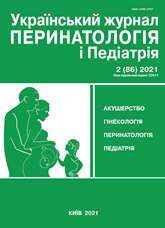Certain clinical and paraclinical markers of sepsis-induced myocardial dysfunction in newborn
DOI:
https://doi.org/10.15574/PP.2021.86.41Keywords:
neonatal sepsis, myocardial dysfunctionAbstract
The problem of neonatal sepsis continues to be one of the leading places in neonatal practice. The issues of early diagnostics of cardiovascular disorders in neonates with sepsis by means of up=to=date methods of examination remain relevant. They can be used as screening methods with the purpose to verify possible development of cardiovascular dysfunction.
Purpose — to study the meaning of certain clinical and paraclinical markers of myocardial dysfunction in neonates with sepsis.
Materials and methods. In order to realize the objective we have observed 69 neonates with signs of generalized infectious-inflammatory process. Group I (32 patients — 46,4%) included neonates with the term of gestation 37–42 weeks, group II included 37 preterm neonates (53,6%) with the term of gestation under 36 week inclusive.
Results. It was found that in mothers who gave birth prematurely, compared to mothers of newborns of group I, premature rupture of membranes occurred more often, but 1.5 times less often — indications of infectious diseases of the genitourinary system of the pregnant woman. Generalized infectious-inflammatory process during the neonatal period of term infants is accompanied by electrocardiographic signs of left ventricular overload associated with female sex (r=0,30), delivery by cesarean section (r=0,27), and assessment of neonatal condition by a 5=minute Apgar score (r=-0,33).
Conclusions. Increased values of lactate dehydrogenase activity in the blood serum of both term and preterm neonates are associated with left ventricular over-load in the term ones, and right ventricular overload in the preterm infants. Changes found in electrophysiological heart activity promote the necessity of a routine use of electrocardiography in neonates with signs of septic process.
The research was carried out in accordance with the principles of the Helsinki declaration. The study protocol was approved by the Local Ethics Committee of all participating institution. The informed consent of the patient was obtained for conducting the studies.
No conflict of interest was declared by the authors.
References
Alzahrani AK. (2017). Cardiac function affection in infants with neonatal sepsis. J Clin Trials. 7: 1. https://doi.org/10.4172/2167-0870.1000329
Bezkaravajnyj BA, Solov'eva GA, Kaminskaja DV. (2010). Funkcional'noe sostojanie serdechno-sosudistoj sistemy u novorozhdennogo s gemoliticheskoj bolezn'ju. Zdorov'e rebenka. 4: 118-119.
Dovnar JuN, Tarasova AA, Ostrejkov IF, Podkopaev VN. (2018). Ocenka jeffektivnosti lechenija novorozhdennyh s prehodjashhej ishemiej miokarda. General reanimatology. 14 (1): 12-22. https://doi.org/10.15360/1813-9779-2018-1-12-22
Juanzhen Li, Botao Ning, Ying Wang, Biru Li, Juan Qian, Hong Ren, Jian Zhang, Xiaowei Hu. (2019). The prognostic value of left ventricular systolic function and cardiac biomarkers in pediatric severe sepsis. Medicine (Baltimore). 98 (13): 15070. https://doi.org/10.1097/MD.0000000000015070; PMid:30921240 PMCid:PMC6456134
Kabieva SM. (2009). Ocenka funkcional'nyh rezervov miokarda u novorozhdennyh detej, perenesshih gipoksiju. Pediatrija. Zhurnal im. G.N. Speranskogo. 88 (5): 14-16.
Koloskova OK, Krecu NM. (2017). Rol' apoptozu u perebigu sepsysu (ogljad literatury). Molodyj vchenyj. 8: 15-17.
Luce WA, Hoffman TM, Bauer JA. (2007). Bench-to-bedside review: Developmental influences on the mechanisms, treatment and outcomes of cardiovascular dysfunction in neonatal versus adult sepsis. Crit Care. 11 (5): 228. https://doi.org/10.1186/cc6091; PMid:17903309 PMCid:PMC2556733
Narogan MV, Bazhenova LK, Kapranova EI, Mel'nikova EV, Belousova NA. (2007). Postgipoksicheskaja disfunkcija serdechno-sosudistoj sistemy u novorozhdennyh detej. Voprosy sovremennoj pediatrii. 6 (3): 42-46.
Prahov AV. (2017). Neonatal'naja kardiologija: rukovodstvo dlja vrachej. 2-e izd. dop. i pererab. Nizhnij Novgorod: NizhGMA: 464.
Saks V, Dzeja P, Schlattner U, Vendelin M, Terzic A, Wallimann T. (2006). Cardiac system bioenergetics: metabolic basis of the Frank-Starling law. J Physiol. 571 (2): 253-273. https://doi.org/10.1113/jphysiol.2005.101444; PMid:16410283 PMCid:PMC1796789
Schwartz PJ, Garson AJrPT, Stramba-Badiale M et al. (2002). Guidelines for the interpretation of the neonatal electro-1. cardiogram; European Society of Cardiology. Eur Heart J. 23 (17): 1329-1344. https://doi.org/10.1053/euhj.2002.3274; PMid:12269267
Singer M, Deutschman CS, Seymour CW, Shankar-Hari M, Annane D, Bauer M et al. (2016). The Third International Consensus Definitions for Sepsis and Septic Shock (Sepsis-3). JAMA. 315 (8): 801-810. https://doi.org/10.1001/jama.2016.0287; PMid:26903338 PMCid:PMC4968574
World Health Organization. (2017). Improving the prevention, diagnosis and clinical management of sepsis. Report by the Secretariat. WHO Executive Board. URL: https://apps.who.int/gb/ebwha/pdf_files/EB140/B140_12_en.pdf.
Zeval'd SV, Makarov LM, Komoljatova VN, Kravcova LA, Keshishjan ES. (2009). «Osobennosti vegetativnoj reguljacii sutochnogo ritma serdca I normativnye parametry intervala Q-T u donoshennyh novorozhdjonnyh detej» Rossijskij vestnik perinatologii i pediatrii. 54 (6): 13-17.
Zhelev VA, Baranovskaja SV, Mihalev EV, Filippov GP, Serebrov VJu, Ermolenko SP, Popova JuJu. (2007). Kliniko-biohimicheskie markery porazhenija miokarda u nedonoshennyh novorozhdennyh. Bjulleten' sibirskoj mediciny. 4: 86-90. https://doi.org/10.20538/1682-0363-2007-4-86-90
Downloads
Published
Issue
Section
License
The policy of the Journal “Ukrainian Journal of Perinatology and Pediatrics” is compatible with the vast majority of funders' of open access and self-archiving policies. The journal provides immediate open access route being convinced that everyone – not only scientists - can benefit from research results, and publishes articles exclusively under open access distribution, with a Creative Commons Attribution-Noncommercial 4.0 international license(СС BY-NC).
Authors transfer the copyright to the Journal “MODERN PEDIATRICS. UKRAINE” when the manuscript is accepted for publication. Authors declare that this manuscript has not been published nor is under simultaneous consideration for publication elsewhere. After publication, the articles become freely available on-line to the public.
Readers have the right to use, distribute, and reproduce articles in any medium, provided the articles and the journal are properly cited.
The use of published materials for commercial purposes is strongly prohibited.

